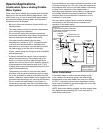
5
IMPORTANT: The water heater should be located in
an area where leakage of the tank or connections
will not result in damage to the area adjacent to the
water heater or to lower floors of the structure. Due
to the normal corrosive action of the water, the tank
will eventually leak after an extended period of time.
Also any external plumbing leak, including those from
improper installation, may cause early failure of the tank
due to corrosion if not repaired. If the owner/operator is
uncomfortable with making the repair a qualified person
should be contacted. A suitable metal drain pan should
be installed under the water heater as shown below,
to help protect the property from damage which may
occur from condensate formation or leaks in the piping
connections or tank. The pan must limit the water level
to a maximum depth of 1-3/4” and be two inches wider
than the heater and piped to an adequate drain. NOTE:
The pan must not restrict combustion air flow. Locate the
water heater near a suitable indoor drain. Outside drains
are subject to freezing temperatures which can obstruct
the drain line. The piping should be at least 3/4” ID and
pitched for proper drainage. Under no circumstance will
the manufacturer or seller of this water heater be held
liable for any water damage which is caused by your
failure to follow these instructions.
1 3/4” maximum
Pipe to
adequate
drain
At least 2” greater than the
diameter of the water heater.
• The water heater should be located in an area not
subject to freezing temperatures. Water heaters located
in unconditioned spaces (i.e., attics, basements,
etc.) may require insulation of the water piping and
drain piping to protect against freezing. The drain and
controls must be easily accessible for operation and
service. Maintain proper clearances as specified on the
data plate.
• Do not locate the water heater near an air-moving
device. The operation of air-moving devices such as
exhaust fans, ventilation systems, clothes dryers,
fireplaces, etc., can affect the proper operation of
the water heater. Special attention must be given to
conditions these devices may create. Flow reversal of
flue gases may cause an increase of carbon monoxide
inside of the dwelling.
• If the water heater is located in an area that is
subjected to lint, dirt, and oil, it may be necessary
to periodically clean the flame-trap and pilot (see
“External Inspection & Cleaning of the Flame-trap” and
“Cleaning the Pilot Assembly” section).
Figure 1
Air-moving
Devices
Reverse flow
of gases
Exhaust
Fan
Clearances and Accessibility
NOTE: Minimum clearances from combustible materials
are stated on the data plate adjacent to the gas control
valve/thermostat of the water heater.
The water heater is certified for installation on a
combustible floor.
• IMPORTANT: If installing over carpeting, the carpeting
must be protected by a metal or wood panel beneath
the water heater. The protective panel must extend
beyond the full width and depth of the water heater by
at least three inches (76.2mm) in any direction; or if in
an alcove or closet installation, the entire floor must be
covered by the panel.
• Figure 2 may be used as a reference guide to locate
the specific clearance locations. A minimum of 24
inches of front clearance should be provided for
inspection and service.
Back
Sides
Sides
Top
View
Top
to
ceiling
Vent
Front
24” minimum
for service
Figure 2
Minimum Clearance
Locations
State of California
NOTE: The water heater must be braced, anchored, or
strapped to avoid moving during an earthquake. Contact
local utilities for code requirements in your area or call
1-877-817-6750 and request instructions.


















